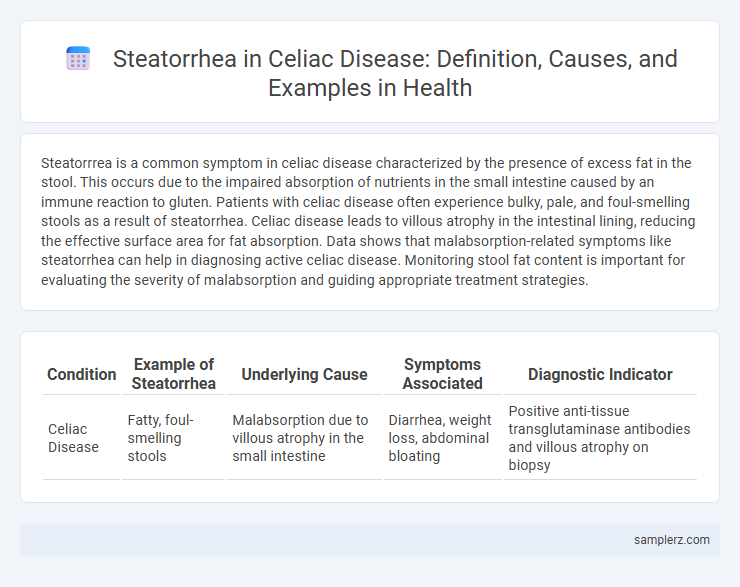Steatorrrea is a common symptom in celiac disease characterized by the presence of excess fat in the stool. This occurs due to the impaired absorption of nutrients in the small intestine caused by an immune reaction to gluten. Patients with celiac disease often experience bulky, pale, and foul-smelling stools as a result of steatorrhea. Celiac disease leads to villous atrophy in the intestinal lining, reducing the effective surface area for fat absorption. Data shows that malabsorption-related symptoms like steatorrhea can help in diagnosing active celiac disease. Monitoring stool fat content is important for evaluating the severity of malabsorption and guiding appropriate treatment strategies.
Table of Comparison
| Condition | Example of Steatorrhea | Underlying Cause | Symptoms Associated | Diagnostic Indicator |
|---|---|---|---|---|
| Celiac Disease | Fatty, foul-smelling stools | Malabsorption due to villous atrophy in the small intestine | Diarrhea, weight loss, abdominal bloating | Positive anti-tissue transglutaminase antibodies and villous atrophy on biopsy |
Understanding Steatorrhea in Celiac Disease
Steatorrhea in celiac disease results from malabsorption of dietary fats due to villous atrophy in the small intestine, leading to bulky, foul-smelling, and greasy stools. The presence of steatorrhea indicates significant mucosal damage and impaired nutrient absorption, often accompanied by symptoms such as chronic diarrhea, weight loss, and nutritional deficiencies. Diagnosing steatorrhea through stool fat quantification helps assess the severity of celiac disease and guides the effectiveness of a gluten-free diet in intestinal healing.
Key Symptoms of Steatorrhea Associated with Celiac Disease
Steatorrhea in celiac disease is characterized by bulky, pale, and foul-smelling stools due to fat malabsorption triggered by villous atrophy in the small intestine. Key symptoms include chronic diarrhea, weight loss, abdominal bloating, and nutrient deficiencies such as fat-soluble vitamins (A, D, E, K). These manifestations reflect impaired lipid digestion and absorption linked to autoimmune damage of the intestinal mucosa in celiac patients.
Classic Stool Appearance: Fatty Stools in Celiac Patients
Steatorrhea in celiac disease typically presents as bulky, pale, and foul-smelling stools that float due to high fat content. These fatty stools result from malabsorption caused by villous atrophy in the small intestine, impairing fat digestion and absorption. Monitoring stool appearance serves as a critical diagnostic clue in identifying malabsorption syndromes associated with celiac disease.
Chronic Diarrhea and Greasy Stools: Main Indicators
Chronic diarrhea and greasy stools are hallmark indicators of steatorrhea in celiac disease, resulting from malabsorption due to intestinal villous atrophy. Patients with celiac disease often exhibit pale, foul-smelling, and bulky stools containing excess fat, reflecting impaired digestion and absorption of dietary lipids. Persistent steatorrhea in celiac disease requires thorough evaluation to prevent nutritional deficiencies and guide appropriate gluten-free dietary management.
Abdominal Discomfort and Flatulence in Steatorrhea
Steatorrhea in celiac disease often manifests as abdominal discomfort characterized by cramping and bloating due to malabsorption of fats. Excess undigested fats in the intestines promote fermentation by gut bacteria, leading to excessive flatulence and foul-smelling stools. These symptoms indicate impaired nutrient absorption and inflammation of the small intestinal mucosa associated with celiac disease.
Unintentional Weight Loss Linked to Fat Malabsorption
Steatorrhea in celiac disease manifests as bulky, foul-smelling stools due to fat malabsorption caused by villous atrophy in the small intestine. This impaired absorption of dietary fats leads to significant unintentional weight loss and nutritional deficiencies such as fat-soluble vitamin deficiencies (A, D, E, and K). Monitoring weight changes and stool characteristics is essential for managing malabsorption and preventing further complications in celiac patients.
Nutritional Deficiencies Resulting from Steatorrhea
Steatorrhea in celiac disease leads to malabsorption of fat-soluble vitamins such as A, D, E, and K, resulting in significant nutritional deficiencies. Patients often experience deficiencies in essential fatty acids and vitamin D, contributing to bone density loss and increased risk of fractures. Chronic steatorrhea also impairs the absorption of other key nutrients, worsening overall nutritional status and complicating disease management.
Diagnostic Clues: Identifying Steatorrhea in Celiac Disease
Steatorrhea in celiac disease manifests as bulky, pale, and foul-smelling stools due to malabsorption of dietary fats. Diagnostic clues include elevated fecal fat quantification exceeding 7 grams per day and positive serologic markers such as anti-tissue transglutaminase (tTG) antibodies. Endoscopic biopsy confirming villous atrophy in the small intestine supports the diagnosis of celiac disease-associated steatorrhea.
Impact of Gluten Ingestion on Stool Characteristics
In celiac disease, gluten ingestion triggers an autoimmune response that damages the small intestine's lining, leading to malabsorption and the presence of steatorrhea, characterized by bulky, pale, and foul-smelling stools rich in fat. The impaired digestion and absorption of fats result from villous atrophy, which reduces the surface area available for nutrient uptake. This alteration in stool characteristics serves as a clinical marker indicating ongoing mucosal injury and the need for strict adherence to a gluten-free diet.
Improvement of Steatorrhea with Gluten-Free Diet
Steatorrhea in celiac disease results from malabsorption due to intestinal villous atrophy triggered by gluten ingestion. Adopting a strict gluten-free diet promotes mucosal healing and restores normal fat absorption, significantly reducing steatorrhea symptoms. Clinical studies demonstrate that patients adhering to gluten elimination experience normalization of stool fat content within weeks to months.

example of steatorrhea in celiac disease Infographic
 samplerz.com
samplerz.com